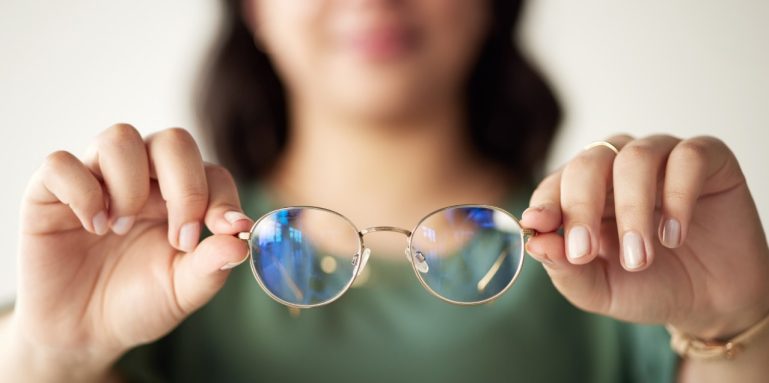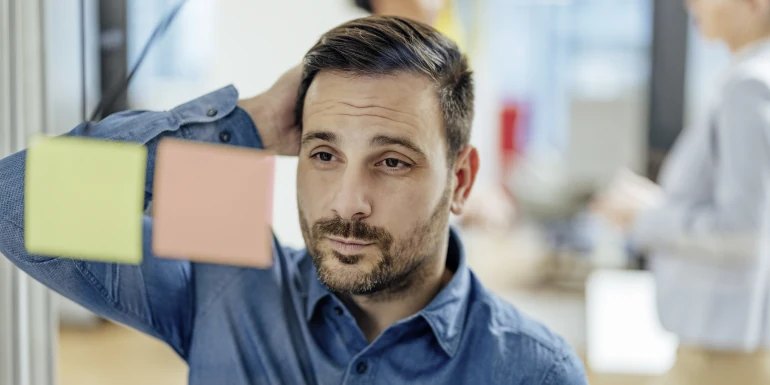
Short-sightedness: causes, consequences & correction
What does “short-sightedness” mean and how does it manifest? How and why does short-sightedness occur? Find out more about the definition of short-sightedness as well as correction through glasses, contact lenses, laser treatment or surgery.
What is short-sightedness?
Short-sightedness (myopia or near-sightedness) is a congenital or acquired form of defective vision. What does this mean for short-sighted people? For short-sighted people, distant objects appear unclear and blurred. Short-sighted people see things that are close up, however, without any difficulty. Experts measure short-sightedness in negative dioptres. Correction is a sensible choice from just -0.5 dioptres. This helps to prevent or slow down the progression of short-sightedness. Correction is recommended for short-sightedness starting from -1.0 dioptres.
Short-sightedness is increasing worldwide. Short-sightedness affects many primary school-aged children. However, studies show that short-sightedness is increasing among adults as well as children. Researchers believe that changing lifestyle habits are one of the reasons for this. Many people frequently look at their smartphones, read or work in front of a screen. They are constantly looking at things that are close up. The eyes adapt to this. At the age of 40 to 50, short-sightedness generally no longer worsens significantly: progressive short-sightedness of more than 1.0 dioptre affects around 20% of adults.
It’s worth noting that short-sightedness and astigmatism are not the same thing. Although astigmatism is a form of defective vision, those affected may experience blurred vision for things that are both close up and far away, depending on severity.
Short-sightedness: the dioptre value
Your dioptre values provide information about how short- or long-sighted you are. If you’re short-sighted, your dioptre values will be negative.
The dioptre table below shows that up to a value of -3.0 dioptres is referred to by experts as mild short-sightedness. Severe short-sightedness ranges from -3.0 to -6.0 dioptres. Above a value of -6.0 dioptres, the short-sightedness is very severe:
|
|
|
|
|---|---|---|
|
|
|
|
|
|
|
|
|
|
|
|
|
|
|
|
Dioptres
Degree of short-sightedness
Correction
Up to -1.0
Very mild
Makes sense
Up to -3.0
Mild
Recommended
From -3.0 to -6.0
Severe
Necessary
Above -6.0
Very severe
Necessary
The difference between short-sightedness and long-sightedness lies, among other things, in the dioptre value: for long-sightedness, the values are positive and for short-sightedness, they are negative. For long-sighted people, things that are close up appear blurred; for short-sighted people, things that are far away appear blurred.
By the way, a combination of short- and long-sightedness is possible. This is the case, for example, with presbyopia (age-related long-sightedness) or anisometropia (difference in power between the two eyes).
Short-sightedness: what are the symptoms?
There are a number of different symptoms of short-sightedness. The usual signs include:
- Headaches
- Dizziness
- Objects in the distance appear blurry
- Streaks or shadows in the field of view
Short-sightedness: what are the causes?
There are two causes of short-sightedness:
- The eyeball is longer than is the case for people with normal vision (axial myopia).
- The lens and cornea refract light too strongly (refractive myopia).
If axial or refractive myopia is present, the light rays are focused in front of the retina instead of on the retina, as would be the case in a healthy eye. As a result, your vision is blurry. A combination of axial and refractive myopia is also possible.
Short-sightedness is hereditary. If both parents are short-sighted, the risk of the child also being short-sighted is 60%. This is known as congenital myopia. The reasons for acquired myopia include excessive close-up work or artificial light: if you often read books or newspapers or spend a lot of time using devices with screens, this can lead to short-sightedness. You should therefore protect your eyes and avoid too much screen time if possible.
Spending two to three hours a day in the fresh air may protect primary school-aged children from short-sightedness. This has been found by various studies. That’s because always watching TV and looking at computer and smartphone screens close up – and the lack of natural light – can contribute to the development of short-sightedness. So let your child play outside in daylight as often as possible. Australian researchers are currently studying whether or not spending time outdoors can have a positive effect on short-sightedness in adults as well.
Short-sightedness: possible consequences
The longer the eyeball, the greater the risk of other complaints. This is particularly true for very severe short-sightedness (above -6.0 dioptres). These are some possible consequences:
- The retina gets thinner, because the eye is stretched.
- This increases the risk of retinal detachment or macular disease. Macular diseases include cataracts or glaucoma. Typical symptoms of retinal detachment include seeing flashes, shadows and what can be described as sooty rain (black dots and spots in the field of view).
Recognising short-sightedness
Arrange an appointment with an ophthalmologist if you suspect that your vision is impaired. They will look at your medical history and carry out an eye test for short-sightedness. There are other possible examinations in addition to this short-sightedness test. For example, they will check the refractive power of your eyes or measure your inner eye pressure.
How can you correct short-sightedness?
There are various ways to correct short-sightedness:
- Glasses: glasses for short-sightedness shift the point at which distant objects come into focus. The point is no longer in front of the retina, but on it. This means that you will see objects clearly again.
- Contact lenses: contact lenses work the same way as glasses. In contrast to glasses, contact lenses allow for optimal visual acuity, even in cases of very severe short-sightedness. For contact lenses to work, your eyes must be suitable for contact lenses, and you must follow the care instructions and attend regular check-ups. If you do so, you can wear contact lenses for a long time without any problems. What contact lenses should you wear if you’re short-sighted? Short-sighted people wear concave lenses with the appropriate corrective power.
- Laser treatment: some ophthalmologists correct short-sightedness using lasers. There are various methods for this. During laser eye surgery, your doctor permanently flattens the curve of your cornea. This compensates for the defective vision. They can also treat astigmatism at the same time.
- Other forms of surgery: lens implantation surgery is suitable for very severe short-sightedness. In this process, your doctor places an implantable contact lens in front of your natural lens. These artificial lenses are also used in cataract surgery, where they replace the natural lens entirely.
If your child is short-sighted, they can choose between children’s glasses or contact lenses. There are no special children’s contact lenses nor a minimum age for contact lenses. It’s therefore best to consult a specialist about the options for your child.
Up to the age of 18, we contribute CHF 180 per year towards spectacle lenses and contact lenses. This benefit is covered by our basic insurance.
Can you train your eyes and improve short-sightedness?
Eye training cannot cure short-sightedness – even though there are providers who offer eye training for short-sightedness. You should instead contact an ophthalmologist, who will tell you about correction options that could suit you.
This is particularly important for children, as short-sightedness often progresses rapidly in children – especially during growth phases. This is why it’s important to recognise short-sightedness early and to arrange regular eye tests (myopia management). This way you can control the progression of your child’s short-sightedness, protect their vision and reduce the risk of secondary issues later on.
Eye exercises are a good idea for adults who spend long periods of time sitting in front of a screen or doing other close-up work. They help to relax the eye muscles and may prevent dry and irritated eyes and headaches. Repeat these exercises several times a day: with your eyes, trace the outline of objects in your workplace – the door frame, the tree outside your window, a picture or the wastepaper basket. Change your viewing distance often: fix your eyes on a point far away and then on another one nearby, then far away again, and so on. Both distances relax the eye. Rolling your eyes and blinking helps to stimulate the flow of tears.
There are many ways to correct short-sightedness – both for children and adults. You may wish to contact a specialist to find out more about this. Together, you can decide which form of correction is suitable for you or your child.

The specialist provided the editorial team with advice and input for this article. Anja Roth (Master of Science in Musculoskeletal Physiotherapy) works for Helsana’s health consultation team. She helps customers with issues to do with prevention and health promotion.


Newsletter
Find out more about current health issues every month and get all the information you need about our attractive offers from all Helsana Group companies * delivered by e-mail to read whenever it suits you. Our newsletter is free of charge and you can sign up here:
We did not receive your information. Please try again later.
* The Helsana Group comprises Helsana Insurance Company Ltd, Helsana Supplementary Insurances Ltd and Helsana Accidents Ltd.